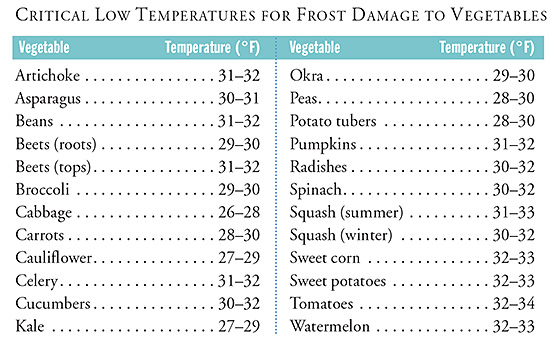Protecting Your Garden From Frost
Protection Tips and Temperature Chart
Protection Tips and Temperature Chart
 Here are tips on how to protect your garden from frost and design a garden to reduce frost damage—plus, a handy chart listing dangerous temperature lows for vegetables.
Here are tips on how to protect your garden from frost and design a garden to reduce frost damage—plus, a handy chart listing dangerous temperature lows for vegetables.To know when your area gets frost, see our U.S. Frost Dates Calculator and the Canadian Frost Dates.
If Frosty Nights Are Forecasted
If temperatures below 32 degrees F are predicted, protect your plants! A moderate freeze with temperatures in the 25- to 28-degree Fahrenheit range can be widely destructive to vegetation.Frost protection is especially important for tender plants such as geraniums, begonias, impatiens, peppers, and tomatoes.
- Use row covers if you have tender vegetable seedlings and transplants.
- Cover other plants with frost cloths or other insulators including newspapers, straw, old sheets and bedspreads, or evergreen branches. Cover the whole plant; you’re trying to retain radiated heat.
- It’s best to have all covers in place well before sunset. Drape loosely to allow for air circulation. Before you cover the plants in late afternoon or early evening, water your plants lightly.
- The plants should be mulched, but pull the mulch back from the root of the plants.
- Remove the covers by mid-morning.
- In the fall, the first frost is often followed by a prolonged period of frost-free weather. Cover tender flowers and vegetables on frosty nights, and you may be able to enjoy extra weeks of gardening.
- In late fall, spread a heavy layer of newspaper (topped off by fall leaves) over a portion of a carrot, parsnip, beet, or rutabaga row to allow these root crops to overwinter in the soil without freezing.
What Temperatures Cause Frost Damage?

Designing Your Garden to Reduce Frost
Here are different ways through which you can reduce the amount of cooling in and around your garden.- Your garden will warm up more during the day if it slopes toward the Sun. Residual heat in plants and soil may determine whether your garden sustains frost damage during the night. Cold air, which is dense and heavy, will flow away from plants growing on a slope—what the experts call “drainage.”
- A garden on a south-facing slope offers two advantages: more exposure to the Sun, and better drainage of cold air. In deep valleys, nighttime temperatures may be as much as 18°F lower than the temperature on the surrounding hills.
- Trees surrounding your garden act like a blanket and reduce the amount of heat radiating from the soil, perhaps keeping the temperature high enough to protect your plants from early fall frosts.
- A stone wall benefits the garden by acting as a heat sink, absorbing warmth from the Sun during the day and radiating it slowly at night. The water in a nearby lake or pond (if it is one acre or larger) does the same. A cold frame can be heated with an improvised heat sink: a dozen 1-gallon jugs of water. They absorb heat during the day and radiate it at night.
- Moisture also determines whether frost will nip your tomatoes. Condensation warms and evaporation cools. When moisture in the air condenses on plants and soil, heat is produced, sometimes raising the temperature enough to save the plants. On the other hand, if the air is dry, moisture in the soil will evaporate, removing some heat.
- Good soil, full of organic matter, retains moisture, reducing the rate of evaporation. Mulch also helps to prevent evaporation.
- Plants themselves can modify cooling. Dark ones with a maroon or bronze cast may absorb more heat during the day. Those that have been planted close together create a canopy that entraps heat from the soil (though the tops can still suffer frost damage). More important, a plant’s cold hardiness determines its ability to withstand colder temperatures.
Predicting Frost
When the sky seems very full of stars, expect frost. –Weather LoreIf it has been a glorious day, with a clear sky and low humidity, chances are that temperatures will drop enough at night to cause frost.
Find out how to predict that a frost is coming!https://www.almanac.com/content/protecting-your-garden-frost?trk_msg=H9I4831K59L4NFQP01UVTBNDF0&trk_contact=EEBLFVJ2I0VAQT9EM5JFVJAK9O&trk_sid=AKP7SUQT7BJ7MD0M959CRUVMUO&utm_source=Listrak&utm_medium=Email&utm_term=Protecting+Your+Garden+From+Frost+(title)&utm_campaign=Companion+Daily








No comments:
Post a Comment